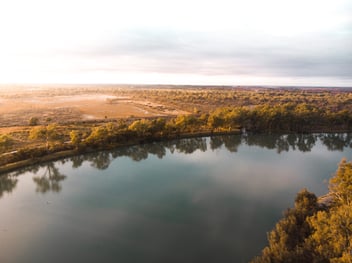Flood management demands continual improvement, expert says
While many communities around NSW are hoping for rain, too much of it can be a bad thing. One dam management expert says balancing timed releases with uncertain forecasting is a huge challenge requiring ongoing improvement.
Set to present at the Australian Water Association NSW Conference in August on flood management, WaterNSW Water Systems Planner Ajantha Prathab said dam management during floods is crucial to the long-term health and safety of downstream communities.
“We face climate variability and there is a lot of development downstream of dams, so we should all understand the risks involved. Not many people understand how floods are managed at dam sites,” she said.
“There is a great misconception that all downstream flooding originates from dams, but natural tributary flows contribute to the majority of flooding downstream.
“Flood planners at WaterNSW take an optimised approach, forecasting flows upstream and downstream, surcharging the dam to the maximum safe level and scheduling dam releases to avoid peaks from downstream tributaries and therefore minimise downstream flood levels.”
Prathab said WaterNSW has a duty of care to ensure its operations minimise damage downstream.
“Floods lead to huge socio-economic loss for communities. The damage can happen so quickly – even an extra half a metre of water can cause a huge amount of loss,” she said.
Prathab has been training storage dam staff on flood operation procedures since 2012, as well as facilitating storage operation training to advise on how gated dams should be managed during flood events.
“We have a long history of well-defined procedures. We’ve had a few projects running for valley-based risk assessment, which looks at identifying any gaps we have in risk management,” Prathab said.
“We came up with a few additional methods. We developed models and tools to manage the existing risks. We developed flood protocols to outline how we would manage a flood incident in the organisation along with combat agencies.”
Prathab said that while flood management procedures are well defined, there are always challenges involved in managing dams effectively during flood events.
“We have very well established procedures in place. In addition to that, we have a forecast planning procedure, which takes into account the rainfall forecast from the Bureau of Meteorology – we assess the likelihood of filling and spilling,” she said.
“We have many tools and models to assess this, but the technology is constantly changing and we need to keep up-to-date with modelling. There is always room for improving procedures with the latest technology. This is what we are working towards at the moment.”
Prathab said the major challenge moving forward is forecasting uncertainty, as dam operators must make decisions about dam releases based on quickly changing rainfall data.
“The major challenge is the uncertainty in forecasting. We have a forecast seven days in advance, but the forecast is expected to change. Every decision we make prior to the event, including pre-releases, involves assessing the potential changes in forecasting,” she said.
“Also, unexpected events are very challenging. We also have statutory obligations to fill the dams for water security and these legislative frameworks guide our decisions too. We may not make a big pre-release because we are obliged to be confident of filling the storage for water security.
“We overcome these by having regular communications with the Bureau and SES to understand the uncertainty. We run our model with the uncertainty, then we consult to decide what we will release. This is important, because SES operates the flood response management.”
Prathab said managing the safety of the dam is a priority during flooding events, as a breached dam could result in massive loss of life.
“It’s very challenging – we have to incorporate information on forecasting to manage the timing of our releases, but at the same time we need to ensure we are not compromising the safety of the dam, which would cause a huge loss downstream,” she said.
Register for the Australian Water Association NSW Conference to hear more from Ajantha Prathab on successful dam management during flood events.

